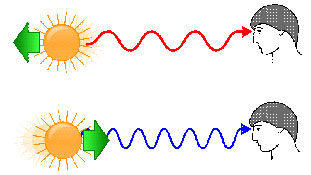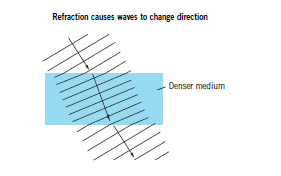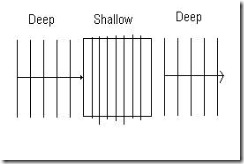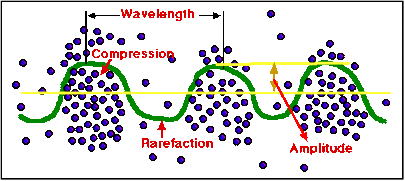Physics T1
- Created by: Jess4989
- Created on: 23-12-17 08:34
Transmittion
- In the transmitter electric current flow alternately up and down at very high frequencies
- This generates radio waves of the same high frequency
- When the radio waves reach the reviever, they make eletric currents of the same high frequency in the radio aerial.
Emmitting and absorbing infrared radiation
All hot surfaces send out (emit) infrared radiation, but black, dull surfaces send out more infrared radiation than any other hot surface.
When infrared radiation goes towards a dull black surface, it is absorbed, making the surface warer, but shiney surfaces reflect the infrared radiation.
Direct proportion and inverse proportion
Variable quantities may be DIRECTLY PROPORTIONAL to each other, INVERSELY PROPORTIONAL to each other. You should understand what these statements mean and you should also know how to test a series of values of two variables to show wether they are directly poportional to each other or inversely proportional to each other.
Direct Proportion
The number of toes in a room is directly proportional to the number of people in the, as illustrated in the table below. If you double the number of of people, you double the number of toes. If the number of people inreases five times, so does the number of toes.
You may well be aware that when two variables are DIRECTLY PROPORTIONAL to each other, a graph of one against the other is a straight line going through the graph origin.
Another way of showing that two variables are DP t
If number of toes is directly proportional to number of people, then
T P and T = constant x P or T/P = constant
Complete the Table above to show that T/P always comes to the same number i.e. is constant.
If X is directly proportional to Y, as X increases, so does Y, but also X/Y (or Y/X) os constant i.e. always comes to the same number.
Another way of showing that two variables are DP t
If i have a large jar containing 1000 Jelly Tots i may feel generous enough to share them out between all the people in the class room. The more people there are in the room, the fewer Jelly tots each one gets. If the number of people (P) doubles, the number of Jelly Tots each one gets (J) halves. The number of Jelly Tots each person gets (J) HALVES. the number of Jelly Tots each person gets (J) is inveresely proportional to the number of poeple in the room (P).
The graph of J against P (or P against J) is not a straight line through the origin, but has the shape shown on Graph 1 below (approximately). A straight line graph through the origin is obtained by plotting a graph of J against 1/P, but that may be beyond the requirement of a GCS course.
To show that two variables are inversely proportio
If the number of Jelly Tots (J) is inversely proportional to the number of people (P), then
If X is inversely proportional to Y, as X increases, Y decreases, but also (X Y) is constant i.e. always comes to the same number.
Newtons second law of motion
The rate occeleration of any object is directly proportional to the pulling force on it, and inversely proportional to the mass of the object.
A force of 1 Newton makes a mass of 1Kg accelerate at 1m/s squared.
3 newtons is what you would need to lift 1Kg at 3m/s squared
4 Newtons is what you would need to lift 4Kg at 1m/s squared
FORCE = MASS X EXCELLERATION
Newtons First Law of motion
An object continues in a state of uniform motion (steady speed) in a straight line unless a resultant force acts on it.
This means that the force on and object moving at a steady speed are ballanced, i.e. there is zero resultant force.
If the bike is at a steady speed, the friction force equals the pedal force, do they add up to zero resultant force.
Significant rays of light going through a CONCAVE
Any ray of light that enters a Concave lens parallel to the Principal Axis is refracted outwards, as if has come from the Principle Focus point. A Concave lens has a Principle Focus on both sides of the lens, as light can be shone through it in either direction.
if this is reversed and the ray of light aimed at the Principle Focus of a Concave lens comes out of the lens parralel to the Principle Axis.
Significant rays of light going through a CONCAVE
Any ray of light directed at the Optical centre of a lens does not refract, but continues straigght through.
Focal length and power
The thicker (more curvey) a concave lense is, the shorter its focal length and the larger is its Power.
Focal length must be in metres, and power is measured in Dioptres (D)
A Concave lens has a negative focal length and a negative Power.
Scalar and Vector quantities
Measurements of Physical quantities can be deivided into broad categories, called Scalars and Cectors.
Vectors are physical quantities that have a direction as well as a magnitude (Force, Displacement, Velocity, Acceleration, weight and momentum)
Scalars are Physical quantities that have a magnitude, but no direction (distance, Speed, Time, mass, energy and power)
Combining Vectors
When Vectors quantities are combined together their direction as well as their magnitude muct be taken into account.
Combining vectors
- Objects A and B both have forces of 5N and 3N acting on them. The combined (resultant) force acting on A is 8N towards the right, but the resultant force on B is only 2N to the right.
- Supposing the two forces are not acting along the same directional line, but at an angle as shown i the diagram below. What is the magnitude of the resultant force on C, and in what direction does it act?
- To find out the magnitude and diection of the resultant force on C we can draw a vector diagram. Each force is represented by a vector arrow in the appropriate direction, whose length represents the magnitude of the force, e.g. we could use a scale in which an arrow of length 1cm represents a force of 1N. Starting from the same point P draw an arrow 3 cm long to represent the 3N force and a 5cm arrow to represent the 5N force. Complete the parralelogram formed by the two Vector arrows. Then draw in the diagonal from P. Measure the length of the diagonal. This represents the magnitude and direction of the resultant force R.
Significant rays of light going through a CONVEX l
Any ray of light that enters a convec lens parralel to the principle axis is refracted through the principle focus point. A convex lens has a principle focous on both sides of the lense, as light can be shone through it in either direction.
Also, if any ray of light that comes from a Principle focus ( or through a principle focus) before hitting the lens comes out parralel tot the principle axis.
significant rays of light going through a CONVEX l
Any ray of light that comes from a Principal fous (or through) before hitting the lense comes out parralel to the Principle Axis.
Focal length and power
The thicker a convex lens is, the shorter is its focal length and the larger is its Power.
Power of a lens =
Convex lens forming a real image from an object wh
From every single point on the object, millions of rays of light spread out, and some of them hit the lens.
Holbies discovery about the universe
In about 1930, Edward Hubbles found that the further away a galexy is from us, the greater the red shift in the light that comes from it.
The origin of our universe
The fact that the galexies are moving away from ech other suggests that long ago they were all together in one place. Along with other evidence, this suggests that our universe may havebegun with an event known as the big bang.At this time, all the smaller of which the universe is made woukd have been in one small place, at extremely high temperature and of enourmous density.
You can use an expanding ballon with 'galaxies' drawn on its surface the bigger the ballon gets, the further out the galaxies are from each other.
The Doppler effect with sound waves
Any object making sound sends out waves which travel at a speed of about 330 m/s in all directions. The wavelength of sound waves varies from about 3cm for very high pitched sounds to about 15 m for low pitched bass sounds.
If the object making the sound is stationary, then the sound waves trvel out equally in all directions and all people who hear the sound hear a note of the same pitch i.e. the same frequency and wavelength.
However, if the object making the sound is moving, then the note that you hear depends on whether the sound shource is moving towards you ar away from you.
The Doppler effect with sound waves 2
If the sound source is moving towards you, the sound waves are compressed closer together, so the wavelength decreases, the frequency increases, and you hear a higher pitched note.
If the sound source is moving away from you, the waves are more spaced out, the wavelength increases, the frequency decreases, and you hear a lower pitched note.

If a light source is moving towards you, the light waves are compresses into a smaller distance, the wave length is decreased, and so the light appears more blue. If a light source is moving away from you, the light waves are streched out, the wavelength increases, so the light appears more red. This is called the red-shift of light. Red and blue shift are only noticable if the source is mobing at enormously high speed e.g. 1000km/s (600 miles per second)
Red Shift
The spectrum of light from many stars (and whole galaxies) shows a significant difference from the Sun's spectrum. Some stars' absorption spectra - exactly the same pattern of absorption lines, but all shifted towards the Red (longer wavelength) end of the spectrum.
The cause of the Red Shift
- If a star (or galaxy) is moving away from the Earth, there is a slightly larger distance between successive waves than normal.
- All light waves from the star, including the absorbtion lines, reach us with a longer wavelength than normal.
- The faster the star (or galaxy) is moving away, the larger the red shift.
- Stars which are moving towards us show a Blue shift (decrease) in wavelength.
Coloured objects
The dyes in coloured objects absorb some colours (wavelengths) and reflect others. A red object reflects red light and all the other colours are absorbed. White reflects all colours and black absorbs all colours.
Colour filters
Colour filters absorb some colours and transmit others. A blue filter transmitts blue light and absorbs all other comours.
colour of light
When light is made of all the colours of the spectrum mixed together. They can be separated as they refract through a triangular prism.
Red = 7 x 10
Violet = 4 x 10
Specular and diffuse reflection
- When light hits a smooth surface like that of a mirror, it obeys the law of relfection and goes off at a very predictable angle. This is called specular reflection.
- When light hits white paper, due due to its relatively rough surface, the light reflects in random direction depending on the angle of the part of the surface. This is diffuse reflection.
Refraction of water waves
Refraction os the change in direction of waves when they move from one medium to another, causing their speed to increase or decrease. This happens to water waves when they go from deep to shallow water, or vice versa. Water waves travel slower in shallow water than they do in deeper water.
Refraction of water waves 2

The time period of a vibration (oscillation)
When waves are travelling through the medium, each particle of the medium is vibrating (oscillating). The time period is the length of time it takes for one complete oscillation. The time period is related tot the frequency of the waves.
The frequency of the oscillation means the number of complete oscillations per second.
Frequency =
Reflection, transmutation and absorption of waves.
When waves reach a boundary between two media, they may be transmitted, reflected or absorbed.
- Microwaves go through glass i.e. they are transmitted
- Sound waves reflect from a solid wall
- Microwaves are absorbed by water
Waves
Wves are repeated movement (oscillations) in a material or medium, which can travel from one place to another carrying energy, without any material moving from one place to the other.
Waves can be Transverse or Longitudinal
Transverse- With an oscillation at 90 degrees to the direction of travel of the wave e.g. water waves, electromagnetic waves.
- Transverse waves have peaks and troughs (in cm, mm, or metres)
The distance between one oscillation and the next is called the wave length. (must be from the identical place on each trough or peak)
Waves 2
Longitudinal - with an oscilation which is parallel to the direction of travel of the waves e.g. sound waves.
The distance from one compression to the next (or rarefraction) is called the wavelength.
Frequency - measured in Hertz, the number of complete waves going past in 1 second (or the number of waves generated per second) is called the frequency of the waves.
A frequency of 15 Hertz means 15 complete waves generated per second.
15 Kilohertz means 15,000 waves per second.
Making wave measurements for Ripple tank waves
The wavelength is 4 cm
The frequency is 18 Hertz ( using a strobe light)
Speed = distance/ time
To find the frequency of the waves in a ripple tank, you use a strobe light. this light flashes the same frequency as the waves and then you read the measurement off the strobe light.
Making sound waves visible
Ultrasound
Ultrasound is sound waves of a frequency higher than humans can hear. i.e. of a higher frequency than 20,000 Hz.
The longer it takes the reflected pulso so get back, the deeper the water.
Ultrasound 2
Sound waves are longitudianal waves that are created by something vibrating, that can travel through solids, liquids and gases, but not through empy space ( a vacuum). Any object vibrating at a frequency larger than 20,000 Hz still generates longitudinal waves, but they cannot be heard by people. Such waves are called Ultrasound.
Although ultrasound waves can travel throiugh all materials, when they reach a boundary between two different materials, some of the ultrasound is reflected and travels back along the direction it has come from. This is used in theultrasound scan equipment which is used to make images of babies in a mother's womb.
Ultrasound in a womb
- The length of time it takes for pulses of ultrasound to be reflected from the surface of the baby's body indicates how far that surfaceis from the Transducter. This information is used to build up a profile of the baby's body, which can be displayed ona screen.
- The images produced by an Ultrasound scan are not very high in resolution i.e. in detail, but ultrasound causes no known harm to the mother or baby. Much more detailed images could be obtained via X-Rays, but this causes ionisation and this could be particualarily harmful to a developing baby. Ultrasound waves are non-ionising so dont carry the same risk.
Ultrasound for treatment
Kidney stones are hard lumps of solid material that can form in the tubes that carry urine from the kidney. They can cause a blockaage which results in pain. Kidney stones can be broken into smaller pieces by directing an intense beam of Ultrasound through the body aimed at the kidney stone. The higher frequency vibration breaks the stone into smaller pieces, which can be passed out of the body with urine.
A cathode ray oscilloscope, CRO
A CRO can be used to display a heart-beat pattern for a patient in intensive care. It can also be used to display the reflected Ultrasound pulses in an ultrasound scan.
Reflection of waves
Sound waves reflection -echos
We heard a loud 'bang' followed quickly by a quieter 'click', caused by the sound wave reflecting from the sports hall baack to us.
The radiation from a hot, black-body radiator
The series of graphs.....................show several things
- The higher the temperatre of the black body, the greater the intensity of ALL wavelengths.
- The higher the remperature of the black body, the shorter the wavelength at which the maximum intensity is emmited.
- At low temperatures, only infrared is emmited ( i.e. no visable light). At higher temperature some red light is emmitted and the object glows red. At even higher temperature's the peak moves to yellow then blue and the object will appear white hot then blue
Infra-red radiation (I.R.R.)
- Hot, dull dark surfaces are the best emitters of I.R.R.
- Dull, dark surfaces are the best absorbers of I.R.R.
A black body radiator is one that absorbs ALL the radiation that hits it and it is also the best possible emmiter of radiation.
Speed of sound in the lab
We used an automatic timer with 2 microphones to measure the speed of sound in the lab.
Distance travelled = 1.75m
Time taken = 5.5m/s
= 5.5/1000
=0.0055s
Speed of sound waves = Distance/Time
=1.75/0.0055
=318 m/s
Internal structure of the Earth
Seismic Waves
- Are generated by earthquakes.
- Travel from the Earthquakencentre throughout the world.
- Include P (primary) waves and S (secondary) waves.
- Give clues to the internal structure of the Earth.
Seismic Waves P and S wave shadow zones
- The S wave shadow zone strectches from 105 degrees to 140 degrees.
- The fact that no S (transverse) waves reach this this zone suggests that there is a liquid part inside the earth. This is the outer core.
- From 104 degrees to 140 degreess no P waves are received because of the refraction of the P waves by the liquid outer core.
Earthquakes
-Part of wave deeper in Earth travels faster because deeper material is more dense.
Both P and S waves travel faster in more dense material.
-When P waves travel from a solid medium to a liquid, their speed decreases, and they suddenly change direction (refract).
When they travel from a liquid to a solid, their speed increases, and they refract again.
Speed
The speed at which waves travel depends on the type of wave and the material (medium) through which it is travelling.
Electromagnetic waves all travel at 300 000 000 m/s in a vacuum and slightly slower in other materials.
Sound waves travel at about 330 m/s in air, at about 1500 m/s in water and at about 5000 m/s in steel.
For all waves:
Speed = Frequency X Wavelength
V = f X
Electromagnetic spectrum
This is a particularly important family of waves which impact hugely on our lives. They can all travel through empty space (vacuum) at a speed of 3000 000 000 m/s, and can travel through some other materials.
- Radio waves - used in radio and TV communication
- Microwaves - used in mobile phone and satellite TV communication, and for heating food.
- Infrared waves - they warm things that absorb them. Also used in TV remote controllers and optic fibre communication.
- Visible light waves - affect the eyes of humans and animals allowing them to see photography
- Ultra- violet waves - Can ionise atoms. Cause suntan and skin cancer. Cause flourescence in invisable security marking.
- X-ray waves - Can ionise atoms. Can kill or mutate cells. Very penetrating. Absorbed by some materials more than others. used to male images of internal body organs and bones.
- Gamma ray waves - Can ionise waves. Can kill or mutate cells. Very penetrating. Absorbed by some materials more than others. Used to kill bacteria on medical instruments and food. Used to kill concerous cells.
These increase in frequency and energy
Related discussions on The Student Room
- Is a myofibril an organelle »
- Viruses »
- Unofficial Mark scheme: AQA GCSE Biology Paper 1 Triple Higher Tier 16th May 2023 »
- Energy dissipated »
- Is my explanation correct? »
- Biochemistry Personal Statement Example »
- AQA A-Level Biology Paper 3 [21st June 2023] Exam Chat »
- Biology question molecules »
- Chemistry »
- Physics Magnetic fields »





Comments
No comments have yet been made